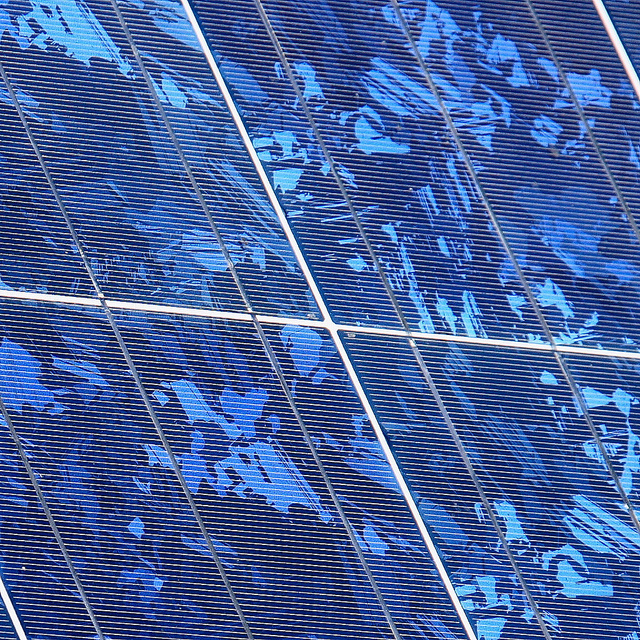
Take a second look at the above photo… look closely. That’s right. It’s not a black roof but rather a roof covered in all black, seamless panels. When you think about solar energy systems, the main vision that usually comes to mind is the solar panels. They are the most visible portion of the entire system – as everything else is wires and electrical components that are not as noticeable. Plus, the solar panels are the biggest part of the system – in terms of physical properties and in terms of usability. The solar panels are the essence of the entire system. They are the mechanism from which sunlight is converted into energy.
Are There Different Types of Solar Panels?
Yes. The majority of solar panels you see are made of crystalline silicon – either monocrystalline silicon or polycrystalline silicon. After these two, the third most common type of solar panel is something called thin-film solar panels. What makes them different?
Monocrystalline silicon solar panels are the most pure form of silicon and the most efficient. They’re also the most expensive.
Monocrystalline silicon solar panels have a very uniform look as the panels are made out of cylindrical silicon ingots to form silicon wafers. The uniform look of these panels is the result of these silicon ingots. Why do people opt for monocrystalline silicon solar panels over the other types? Made out of the highest grade silicon, these panels are efficient in energy generation and also space efficient because of their efficiency. Lastly, monocrystalline silicon solar panels have a long life expectancy (25 years or more) and tend to work better in low-light conditions.

Polycrystalline silicon solar panels are also made out of crystalline silicon, like their monocrystalline silicon cousins, but they are less efficient and less pure. Manufacturers melt raw silicon and put it into molds to form and cut the silicon wafers that make up the solar panel. Why do some homeowners choose these types of solar panels over any others? These types of solar panels are less costly and even though they might be a tad less effective in high heat conditions, the effect is pretty minimal on the functionality of the systems and not one that most homeowners find to be a game-changer.
![]()
Thin-film solar panels are different from those panels made out of crystalline silicon. Thin-film panels are made by applying a very thin layer of photovoltaic material on a substrate, like glass, metal, or plastic. Thin-film solar panels are the least efficient out of all three, but have a uniform appearance. We’re talking about a pretty significant range of efficiency from top level (monocrystalline silicon solar panels) to the least efficient thin-film solar panels – a range from 5% efficiency to about 22% efficiency. For this reason, most solar panel owners who go with thin-film solar panels have to install more panels to generate enough energy from thin-film panels. What does this mean if you are purchasing solar panels for a residential installation? Thin-film solar panels are probably not feasible, because you won’t have enough roof, or enough land to hold the number of panels you’d need to buy to power your house.

Appearance is Everything
By now, most people are aware of the financial and environmental benefits of solar energy systems. Solar energy is a clean source of energy, allows us to reduce our carbon footprint, and to save money on our electric bills every month. What’s not to love? These things are great. . .but, we are a society of appearance – we like attractive things, and this does not exclude solar panels. So what is a non-ugly solar panel like? Well, this is a matter of choice, ultimately, but, most people enjoy the appearance of monocrystalline silicon and thin-film solar panels more because they are uniform.

These solar panels are uniform in color.
Both monocrystalline silicon and thin-film solar panels are black in color, with no variation in color, and a sleek look. Polycrystalline silicon panels on the other hand are less attractive as their color is a blue variation – a result of the multiple crystals that make up the product. Some people think these types of panels are less attractive because they do not have a uniform appearance.

Notice the broken coloring of these polycrystalline silicon solar panels.
Another factor to consider when talking appearances is, if your panels are mounted on your roof, what type of angle will they be at, will they fit flush against the roof, or, if your system is a ground unit, what do the connections look like and how much space will they take up? So, what’s the best option – appearance-wise? Well, if you like a uniform, dark, look, with less tilt, less fuss, and more efficiency, go with monocrystalline silicon panels. They will cost more up front, but you need to feel comfortable living in your own home and looking at your house positively every day when you pull in your driveway.
What’s the Bottom Line?
If we’re talking about appearances, to each his own. But, most individuals prefer a sleek design. The monocrystalline and thin-film solar panels are your best bets if this is your desire. Polycrystalline silicon solar panels are fantastic products, but some people do not care for the appearance of them. They are multi-faceted and a more noticeable blue color than their black counterparts.
While we’re talking about it, some might say that the focus shouldn’t be on the appearance, it should be on how well it works and the savings you’ll generate from powering your house from the sun. But, we spend a lot of time making our homes beautiful. Why shouldn’t solar panels be given the same amount of respect? After all, considering the installation of solar panels can increase your home’s value – if you go to sell your home, you’ll want to make sure the appearance of your panels is a crowd-pleaser to get the best return on investment.

